How can I help autistic pupils develop more independence in learning tasks?

By Sarah
One of the most common issues we come across when going into schools is children struggling to work without constant prompting. This can be for a variety of reasons including (but not exclusively) fear of failure, difficulty getting started (the dreaded blank page problem!), distractions in the environment around them, trouble understanding the work or lack of motivation/sense of purpose. Another key factor is that a lot of the children we work with have had a 121 TA with them for years. Often, they haven’t had to ever sit and work by themselves and as a result, they can become dependent on the constant prompts that they are used to.
Don’t get me wrong, I know that some children really do need specific support. There are many TAs (and teachers) out there are doing their best to help autistic children succeed. You’re all great and you hold schools together – we know this. But what is increasingly common – with expectations for both children and teaching staff becoming increasingly pressurised – is that we as the adults also have a fear of failure when trying to support children’s learning. If they don’t do enough work, our work ethic is scrutinised. If they don’t answer all the questions, our ability is questioned. If they lack motivation, our motivations must be lacking.
So, when you read these suggested strategies please know that they are written from a place of understanding and empathy. They are options, advised tactics, and potential ideas in your toolbox which may work some days but not on other days. They may work wonderfully for Child A but get Child B absolutely nowhere. We know that autism is never one-size-fits-all but hopefully some of these strategies will at least start a conversation about how we can begin to develop some of this much-needed independence in our children (whether autistic or not!)
It is also worth reading the research from the Education Endowment Foundation on the best use of TAs which we discuss in our TA mentoring course. We think about how we might enable children to think for themselves when faced with a problem and how we might sit back and give them that thinking time, whatever the pressures around us to get on with it are.
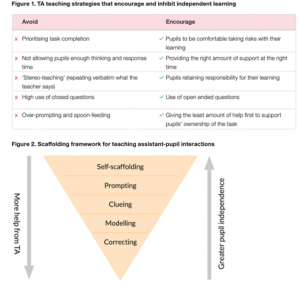
From p15
It’s also worth noting that you may be a parent reading this who is home-schooling through choice or necessity. As we go through, I’ll try to suggest ways that this can be adapted for a home environment too, as many of these strategies will be helpful as children try and complete homework or house chores too.
How can we support autistic children to work independently?
Environment
One of the main struggles for children trying to work in a classroom (or hectic home environment) is the constant distractions around them. They have all the best intentions to sit and focus on their work but somebody is talking nearby, a bird just flew past the window, their seat is uncomfortable and someone just started using the hand dryer after flushing the toilet. Start by checking what your child needs.
- Ear defenders or putting music on (either out loud or with headphones on) may drown out some other auditory distractions and help them focus.
- A stability cushion or weighted blanket over their legs may help children feel grounded and calm, enhancing their ability to focus.
- Sitting alone or further apart from others may be useful, especially if they have a chatty or fidgety table partner/sibling!
Workstations
In order to cut out some of these distractions (especially the visual ones) you could put up a cardboard box around the edge of their table to create a workstation. This creates a wall without making them sit facing a wall and the great thing is that it’s portable. Need it for Maths? Pop it up. Don’t need it during group work in English? Take it down. If you want it to be a more permanent fixture then of course you can leave it up on their own table but it’s nice to have the option. This is useful for parents who want to make it clear to their children when it’s homework time and when it’s playtime. If the workstation is up, it’s time to work. Take it down and the message is clear – work time is finished.
Within the workstation, you may want to personalise it with the child’s name or a couple of pictures but don’t let the workstation get too cluttered. Only get out the resources they need for that lesson – you don’t need every workbook and word mat on display all the time. Cut out the clutter and keep it simple, otherwise it may become a distraction in and of itself!
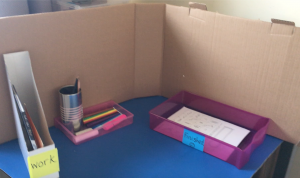
With all our strategies we recommend that you do them with the child. Please don’t suddenly set it up one Monday morning as a “surprise” – this often doesn’t go down as well as we’d hope! Autistic children often find change difficult, struggle to cope with the unpredictable and many of them have deep seated anxiety and self esteem issues. If you suddenly give them their own table with a workstation all set up without any prior warning they may just end up confused, worried and might even feel like it’s a punishment because they haven’t been working hard enough. Take the time to talk about it with them first, explain that we’re going to give it a go to see if it helps them focus and show them pictures of adult workstations so they recognise that it’s a lifelong strategy that they can use (not anything baby-ish or patronising) like this:
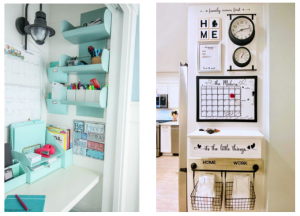
photos from Pinterest
Let’s leave workstations for now but I’ll come back to them later…
For more info on sensory support check out this blog: https://reachoutasc.com/what-is-a-sensory-diet-and-how-do-i-implement-one-in-my-busy-classroom/
2. Chunking
I don’t know about you but I have a list for just about everything: chores, holiday packing, meal ideas – you name it, I have a list for it. Why do we do it? Often, it’s because our brain appreciates us breaking things down into smaller chunks. It helps us to process what needs doing, things seem more manageable and we get a sense of achievement every time we cross something off. Our aim with the next strategy is to do the same thing with school work. Especially as children get older, they are given whole worksheets full of information or questions and it can be difficult for autistic children to know which bit to focus on first or how to process it all effectively. By breaking it down, we’re making this tricky task a little bit more manageable. It also helps to keep it visual – how many times do you have to give an instruction to tidy their room? Writing it down gives autistic children something to refer back to, thus building independence (and saving your sanity) as you point them back to the visual instead of repeating the instruction.
Work schedules
These are so easy to adapt and personalise for your child, depending on what their interests are, how old they are and how easy/difficult they currently find independent working. The aim is simple – complete short, manageable tasks to work towards a quick, motivational reward. The aim is to keep it visual and work with whatever attention span the child has in order to tick things off. Rather than trying to push them through a big long list of tasks, the work schedule breaks it down into short bursts of productivity with regular breaks in between, supporting them with that visual reminder.
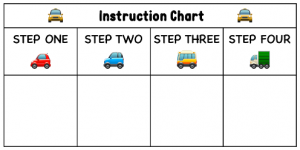
I used this example with a Reception child who couldn’t process more than one instruction at a time. We started with “one instruction = reward” and over time we built it up to following “two instructions = reward” and so on. Does it require patience? Yes. Is it slightly more time consuming to write down/draw the instruction? Yes. But does the child build independence? Yes.
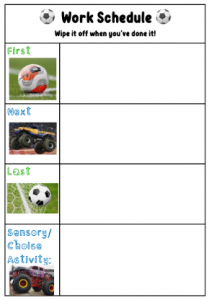 This second example is for a child in year 2 who initially loved monster trucks and football! After two weeks of using this, he decided that actually he loved Minecraft more than anything else in the world. No problem – we simply stuck pictures of Minecraft over the other photos and the work schedule was back in business. For this child, he was able to manage 2 or 3 tasks before getting a quick reward. He still needed lots of modelling and scaffolding to begin with but over time, as he became more
This second example is for a child in year 2 who initially loved monster trucks and football! After two weeks of using this, he decided that actually he loved Minecraft more than anything else in the world. No problem – we simply stuck pictures of Minecraft over the other photos and the work schedule was back in business. For this child, he was able to manage 2 or 3 tasks before getting a quick reward. He still needed lots of modelling and scaffolding to begin with but over time, as he became more comfortable and familiar with it, his independence grew.
Note: the reward doesn’t have to be time-consuming or lots of extra work for you. I worked with a year 1 child who loved those little pop up toys so for her, this was a super motivational reward. (We wrote all our numbers to 15 and read a whole reading book in 20mins just by using a 1-step work schedule with the pop up toy as a reward each time).
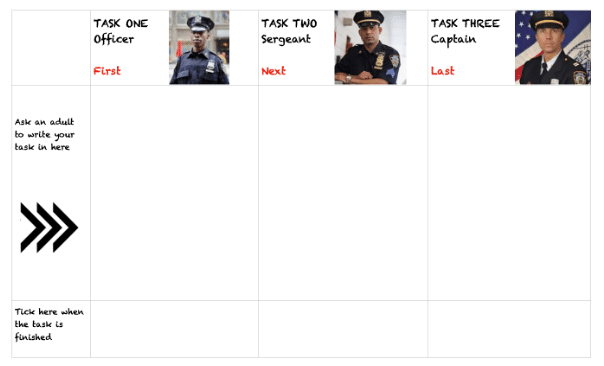
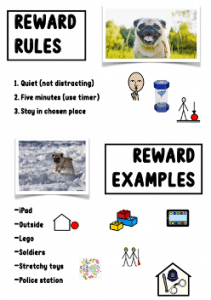 This third example was used with a child in year 6 who loved the NYPD. When I went back for my first visit after giving them the work schedule his unfiltered autistic honesty shone through as he told me straight up “oh, we never use that!” Goooood. It turns out he was being asked to get through all of morning challenge, all of English, and all of Maths before he got a reward. This is just too much! We want to use this resource to break everything down into little chunks so that the reward is always within reach. Waiting almost 3 hours for a reward may be attainable for children who are already pretty independent or have used a work schedule for a while but as a first step it was too big a jump. For this child, it was also helpful to give him some rules for the reward so that it wasn’t distracting and difficult for others around him. He chose to play a game on the iPad as his reward so we agreed the rules with him and stuck them on his table. Again, visual support and an active discussion helped this strategy to succeed. We don’t want children to feel confused or out of control; these strategies are supposed to help them!
This third example was used with a child in year 6 who loved the NYPD. When I went back for my first visit after giving them the work schedule his unfiltered autistic honesty shone through as he told me straight up “oh, we never use that!” Goooood. It turns out he was being asked to get through all of morning challenge, all of English, and all of Maths before he got a reward. This is just too much! We want to use this resource to break everything down into little chunks so that the reward is always within reach. Waiting almost 3 hours for a reward may be attainable for children who are already pretty independent or have used a work schedule for a while but as a first step it was too big a jump. For this child, it was also helpful to give him some rules for the reward so that it wasn’t distracting and difficult for others around him. He chose to play a game on the iPad as his reward so we agreed the rules with him and stuck them on his table. Again, visual support and an active discussion helped this strategy to succeed. We don’t want children to feel confused or out of control; these strategies are supposed to help them!
Organisation
One thing that can hinder independence is not having the right thing at the right time. Your child may be very capable of writing 3 sentences in one go…if only they could find their pencil. Or maybe your child could sit and focus for the whole lesson on their maths problems…if only they knew where their worksheet was. One of the benefits of using these strategies is that we’re not only getting work done (hopefully!), we’re also teaching them life skills. If they are able to organise themselves and independently find the relevant equipment/worksheet then they’re well on the way to being successful in life, as well as their potential academically.
Workstation + work schedule
For the ultimate combo, use the two strategies together. You could laminate the work schedule and stick it up on one of the workstation walls. Alternatively, cut the work schedule into strips and put each strip in an envelope for children to open. You could use a magazine folder or tray to put the “to-do” work in so it’s clear what still needs to be done. Make sure you have a finished tray or folder. This helps children to stay organised, gives a focus/purpose to the task and also helps them feel a sense of accomplishment as that tray fills up throughout the lesson or day.
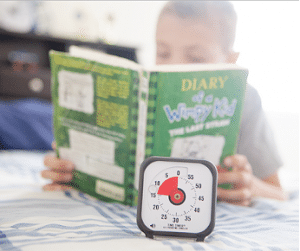
For some children, it may be helpful to use these strategies alongside a timer. Instead of saying “task one: complete maths question one” it might be more helpful to say “task one: work on maths for 2mins”. This gives children something to aim for, especially if you know that they’re going to really struggle to complete maths question one without any support from you. After their 2mins of trying independently, then you can go and help them – but we’re still building resilience through encouraging them to have a go on their own first. Timers can also be helpful to ensure that rewards don’t go on forever! Again, explain to the child that the aim here is to get work down so we can proud of ourselves/learn more etc etc. Be honest with them – “I know you could just turn the timer over again and tell me you didn’t but I’m going to leave it with you and trust that you’ll make the right decision”. It can be a little scary to put the power in their hands but let’s give them the chance to surprise us and make a BIG deal if/when they make the right choice. Note: Give them more than one chance to make the right decision here. Don’t be afraid to call them out if you spot them giving themselves extra reward time, but talk to them about how these strategies are to help teach them life skills and let them know that you’ll give them another chance. How often do we get second chances in life when we mess up? Let’s talk to our kids about that too so they know that we’re on their side, cheering them on and willing them to succeed!
4. Quick ideas
Just before I finish, here are 8 ideas for quick, motivational rewards. It doesn’t need to be rocket science – just find something that your child really gets on board with. Ask them, give them options, and encourage them to take ownership of it. Note: If your child doesn’t use speech you can still ask them what they would like. Use visuals to support communication and still seek to include them in these decisions.
- Pop up toy (as mentioned before – a winner with several of the children I work with)
- Sensory items (helpful for those kids who have sensory needs anyway – this helps keep their body alert in between work periods. Note: Be careful that you don’t withhold these from children that need them to stay regulated during the day! They are more necessary for some children than others.)
- iPad (simple yet effective. Decide rules together about what games they can play, whether they need to use headphones, where they need to use it etc)
- Book (some kids will love retreating to the book corner for 5 mins – rewards can be educational too!)
- Music (this can be a really lovely way for kids to de-stress if they can listen to a soothing piece of music or their favourite song in between tasks)
- Drink of water (yes – it can be this simple! This may be good for those kids who want/need to stretch their legs or have a wriggle – let them walk to the water fountain in between tasks.)
- Lego (if children are only allowed to build for 1 or 2 mins in between tasks why not challenge them to see how much they can build by the end of the day? This can be a very satisfying and motivational way to get work done.)
- Drawing/colouring (lots of children find the mindfulness colouring sheets very therapeutic and relaxing which can be especially useful if they’re finding the work stressful and difficult)
It will probably take time for both you and your autistic child to get used to these strategies. Give it a couple of weeks minimum before giving up, and keep explaining to the child what you’re hoping to get out of it. If they’re not on board then it’s not to going to work – but it might take some time to process how it works. Building independence is best done through cooperation with the child so they can enjoy their progress. Knowing when to ask for help and knowing that they can help others is part of that too. So keep going! You’ve got this.
You can find out many more ways of supporting autistic children in primary schools with our CPD accredited courses at Schudio TV. This is a great one to start with https://www.schudio.tv/courses/supporting-autistic-learners-primary (only £24 individually or get all our courses for only £12 a month as a Getting It Right member)


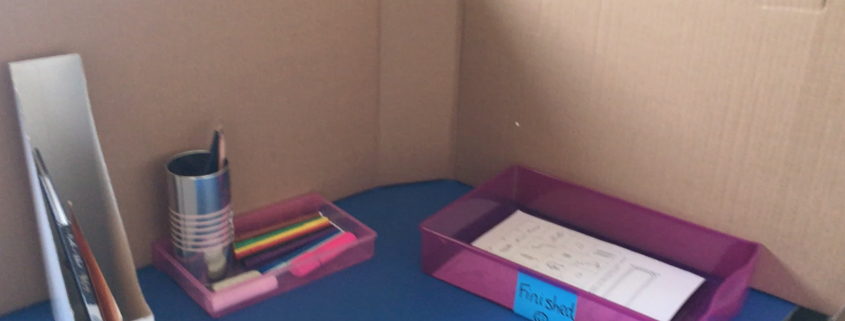 Lynn McCann
Lynn McCann www.pixabay.com
www.pixabay.com Lynn McCann
Lynn McCann